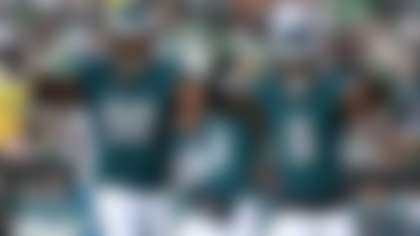Super Bowl LIV feels like the most compelling title game matchup in years, with the San Francisco 49ers taking on the Kansas City Chiefs. Both teams feature a dynamic offense, but they take different approaches to lighting up the scoreboard.
The 49ers field an old-school ground-and-pound attack, with a dominant running game complemented by an efficient quarterback who can make big-time throws in key moments. Although Jimmy Garoppolo hasn't been asked to chuck it much in the playoffs, he put together a highlight reel of pinpoint passes during the regular season with games hanging in the balance. Meanwhile, the Chiefs' offense is fueled by a generational passer who distributes the ball to a collection of playmakers with the speed and explosiveness of an Olympic track team. Patrick Mahomes' exceptional arm talent and limitless range enable Kansas City to score from anywhere on the field at any time. Defensively, the 49ers are powered by a star-studded line that features five former first-round picks in the rotation. The Chiefs' D has been sparked by the re-emergence of Tyrann Mathieu as the ultimate playmaker in the secondary.
With so many blue-chip players set to take the field on Sunday in a game for all the marbles, I wanted to outline a five-point blueprint to victory for each team. Here's what San Francisco needs to do in order to hoist the Lombardi Trophy:
1) Bludgeon the Chiefs with the dressed-up run game until they stop it.
The 49ers have made their way to Super Bowl LIV by pummeling opponents with a smashmouth ground game powered by a three-headed monster at tailback. With Tevin Coleman, Raheem Mostert and Matt Breida operating in a zone-based scheme that tests the discipline and integrity of a defense's front seven at the point of attack, San Francisco fielded the second-best rushing offense in the NFL in 2019 at 144.6 yards per game. The collective athleticism of the offensive line and the decisiveness of the running backs (one cut and go) have led to a number of explosive plays from the Niners' ground attack. The team finished tied for second in the NFL with 16 runs of 20-plus yards. These chunk plays enabled the 49ers to light up the scoreboard to the tune of 29.9 points per game (second in the NFL) while utilizing a fairly conservative approach.
That said, San Francisco adds some pizzazz to the run game by featuring a variety of pre-snap shifts and motions on nearly every offensive snap. This is certainly not a surprise, given Kyle Shanahan's long history of dressing things up as a play caller. Still, according to Pro Football Focus, Shanahan has increased his shift/motion rate by about five percentage points in each of the last four seasons. He has also led the NFL in shift/motion rate during each of the last four seasons, with the 49ers employing such action on a whopping 78.6 percent of offensive snaps in 2019. A big part of the Niners' success with their shift movement plan can be attributed to the versatility of tight end George Kittle and fullback Kyle Juszczyk. These two Pro Bowlers are adept at sealing the edges from their respective positions as hybrid lead blockers/playmakers on the perimeter, which enables Shanahan to move them around to put them in favorable positions to execute their blocks. With Kittle and Juszczyk constantly shuttled between various spots, particularly on running plays, the 49ers have averaged 5.3 yards per rush on runs preceded by pre-snap motions, per PFF, compared to just 3.4 yards per rush on non-motion runs.
Against the Chiefs, San Francisco should continue with the dizzying tactics, given Kansas City's struggles against the run -- particularly against runs preceded by shifts or motions, when K.C. has allowed 5.2 yard per rush. The soft edges allowed by the Chiefs' defensive ends should encourage Shanahan to attack the perimeter with a variety of outside zone plays preceded by Kittle or Juszczyk moving into advantageous spots to crack or reach defenders on the edges. The 49ers should run the ball over and over until Steve Spagnuolo's unit proves that it can stop it.
2) Unleash Jimmy Garoppolo as a deep-ball thrower off play action.
It's uncommon for a QB1 to advance to the Super Bowl without playing a leading role on offense, but Jimmy G only threw the ball 27 times during San Francisco's two playoff wins, producing a grand total of 208 passing yards. Still, despite the 49ers' season-long ground-and-pound success, you have to figure Garoppolo will need to make a handful of plays in the passing game to help San Francisco keep pace with the Chiefs' high-octane attack.
On deep balls, according to Next Gen Stats, Garoppolo actually led the NFL in completion percentage (58.1) and yards per attempt (20.3), while also totaling seven passing touchdowns and posting a 102.6 passer rating on such throws. Interestingly, Jimmy G has been able to post those robust numbers with the lowest deep-pass percentage (6.2) in the NFL.
Jimmy G's success in this area has been fueled by the 49ers' mirrored play-action package tied to outside zone runs. According to Pro Football Focus, No. 10 ranks within the top five in completions (53), yards per attempt (11.3), passing touchdowns (4) and passer rating (122.7) on outside zone play-action passes. With the 49ers running outside zone on 34 percent of their runs this season (sixth-most in the NFL, per PFF) and averaging 5.1 yards per rush on these stretch plays, it's sensible for the team to utilize complementary play-action passes. San Francisco's 82 dropback passes off outside zone action rank as the third-most in the league this season. This is all part of a philosophical approach that had the Niners use play action on 32.4 percent of dropbacks -- the third-highest figure in the NFL.
With that in mind, I would expect Shanahan to attack the Chiefs' defense with a handful of well-designed shot plays that mirror outside zone runs. Garoppolo will fake the stretch play before setting up behind the tackle on a traditional play-action pass or he will roll away from the action on a bootleg pass that takes advantage of overaggressive defenders among the front seven. Additionally, San Francisco's QB will target one of Kansas City's most vulnerable perimeter defenders (Charvarius Ward or Bashaud Breeland) on a double move or deep crossing route against one-on-one coverage. The overabundance of "plus one" defensive fronts employed by the Chiefs will leave their cornerbacks on an island, and a well-designed vertical route by Deebo Samuel, Emmanuel Sanders or Richie James could lead to a walk-in score on an early-down shot play following run action.
3) Make Patrick Mahomes produce from the pocket.
The reigning league MVP might be the best quarterback in the game at the moment, based on his combination of arm talent, athleticism and playmaking ability. Mahomes is a scoring machine with the ball in his hands, as evidenced by the Chiefs averaging 32.6 points per game in his career as a starter -- the highest mark for any QB since 1950.
No. 15 has become an even more dangerous playmaker this postseason by utilizing his athleticism to make plays as a runner and improvisational passer. This has given the Chiefs' already-explosive attack an added dimension, which is frightening. The combination of runs and scramble tosses stresses the defense at every level, leading to big gains on broken plays. In this postseason, per Pro Football Focus, Mahomes has upped his scramble rate to 12.2 percent -- up from 4.6 percent during the regular season. In January, Mahomes averaged 11.2 yards per rush, with a 70 percent first-down conversion rate. In addition, Mahomes has four passing touchdowns while on the run this month, which is twice as many as any player in a single postseason since at least 2016, according to Next Gen Stats.
With all that in mind, the 49ers must keep No. 15 in the pocket and force him to play as a traditional quarterback. Although he has been magnificent as a pocket passer over the past two seasons, the 49ers must eliminate the explosive plays from the Chiefs' offense and force them to drive the length of the field on an assortment of short passes, thus testing Mahomes' patience and discipline as a playmaker.
Opponents have enjoyed the most success against Mahomes when sending four or fewer pass rushers. Over the past few seasons, the Chiefs star has tossed 16 of his 17 interceptions while facing seven or more defenders in coverage. Predictably, Mahomes' interception rate under pressure against four or fewer pass rushers (3.5 percent) is significantly higher than his interception rate when not under pressure against four or fewer pass rushers (1.2 percent). So, if the 49ers' vaunted first-round defensive line (Nick Bosa, Arik Armstead, DeForest Buckner, Dee Ford and Solomon Thomas) can remain disciplined while rushing the depth of the quarterback's drop, San Francisco can curb some of the scrambles and improvisational plays that have resulted in big gains for the Chiefs and ignited an offense with the capacity to get white-hot in a hurry.
4) Take away Kansas City's deep ball.
Whenever a defensive coordinator faces this K.C. offense, he has to make stopping the deep ball the No. 1 priority. These Chiefs are the NFL version of yesterday's Golden State Warriors, with the deep ball viewed as their three-point shot and Mahomes impersonating Steph Curry as a scoring point guard. Mahomes led the NFL with 13 touchdowns on deep passes, averaging 16.5 yards per attempt with a 121.1 passer rating on such throws. Those numbers are eye-popping -- and they match the explosiveness that shows up on tape. The Chiefs have a 4x100 meter relay team on the perimeter, with Tyreek Hill, Sammy Watkins, Mecole Hardman and Travis Kelce blazing the turf. Most teams are ill-equipped to deal with their individual and collective speed, which exposes the secondary to big plays when Mahomes spots a favorable matchup.
The 49ers have been exceptional defending the deep ball throughout the regular season and playoffs due to their awareness and discipline within their zone-based scheme. But Kansas City obviously presents quite the challenge on this front. Whether it's passing off the deep crosser in quarters coverage (four deep) or properly executing "2 to 1" reads in Cover 3 (three-deep zone), the 49ers' defensive backs must understand the Chiefs' vertical route concepts and the leverage needed to take away the deep ball.
Keep in mind, the 49ers held opponents to the second-lowest completion percentage (23.1) on deep passes this season, which reflects their emphasis on the elimination of home run plays. While most of the work in this area will be done by the secondary, the 49ers' pass rush can play a significant role by generating consistent pressure on Mahomes. If the 49ers are able to harass No. 15 with a traditional four-man rush -- utilizing an assortment of games, twists and stunts -- the defense can play a variety of max zones featuring seven defenders in coverage with their eyes affixed to the quarterback. This will not only help San Francisco keep the ball in front of the defense, but it will put enough defenders in coverage to rally to the ball when the tactics force checkdowns to underneath receivers.
5) Don't let K.C. get loose in the return game.
The Chiefs' return teams might be the most dangerous in the NFL, with Pro Bowl return specialist Hardman providing Andy Reid with a game-changing weapon on special teams. The rookie speedster is capable of scoring from anywhere on the field, with his combination of explosiveness and running skills making him a nightmare for coverage teams. Despite having only one return score on his resume in 2019, Hardman's big-play potential makes it imperative for the 49ers to maintain their lane integrity on each and every kick throughout the game.
In K.C.'s awe-inspiring comeback win over Houston in the AFC Divisional Round, Hardman's 58-yard kickoff return sparked the Chiefs' offensive explosion. He not only provided the offense with prime field position, but gave the unit some much-needed energy with a spectacular run that ignited the crowd. Considering the potent nature of Kansas City's offense, the 49ers can't afford to give Mahomes and Co. a short field to increase their odds of putting the ball in the paint.
Hill also deserves mention as the Reid's designated home run hitter in the return game. He's only fielded a pair of punts on the season, but the memory of the former Pro Bowl returner zipping across the field a few years ago should put the entire 49ers coverage squad on notice if they see No. 10 step onto the field for a return.
Follow Bucky Brooks on Twitter @BuckyBrooks.












